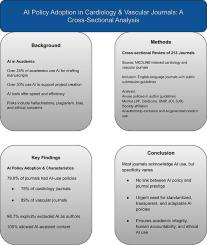探索AI在心血管期刊稿件写作中的使用策略
IF 1.8
Q3 CARDIAC & CARDIOVASCULAR SYSTEMS
American heart journal plus : cardiology research and practice
Pub Date : 2025-08-08
DOI:10.1016/j.ahjo.2025.100586
引用次数: 0
摘要
人工智能(AI)技术正在迅速发展,并提高了手稿生成的效率,然而,这项技术引起了人们对潜在的偏见、错误和抄袭的担忧。作为回应,一些期刊已经更新了作者指南,以解决人工智能的使用问题。方法我们评估了213篇medline索引心血管期刊的作者指南,以评估人工智能在论文写作中的使用政策。期刊指标如CiteScore、期刊影响因子(JIF)、期刊引用指标(JCI)、论文来源标准化影响(SNIP)和SCImago期刊排名(SJR)在有和没有人工智能政策的期刊之间进行了比较。我们进一步分析了人工智能政策采纳与社会隶属关系之间的关系。我们审查了将AI列为作者的标准以及AI生成内容的许可。结果213种期刊中,170种(79.8%)的人工智能政策在评估中保持一致。147份心脏病学期刊中有115份(78%)和127份血管学期刊中有113份(89%)存在相关政策。此外,143个期刊中有111个(77.6%)有人工智能使用政策,而70个期刊中有59个(84.2%)是非附属期刊。期刊指标在有和没有人工智能政策的期刊之间没有显著差异(P >;0.05)。在有政策的158家期刊中,156家(98.7%)将AI排除在作者之外,而所有期刊都允许AI辅助内容。结论:许多心血管期刊都涉及人工智能生成的内容,但在政策和对人工智能生成的手稿的披露要求方面仍存在差距。人工智能使用政策的存在独立于期刊指标或社会隶属关系。本文章由计算机程序翻译,如有差异,请以英文原文为准。

Exploring AI use policies in manuscript writing in cardiology and vascular journals
Background
Artificial intelligence (AI) technologies are rapidly evolving and offer efficiencies in manuscript generation however, this technology has raised concerns about the potential for bias, errors, and plagiarism to occur. In response, some journals have updated their author guidelines to address AI use.
Methods
We assessed author guidelines for 213 MEDLINE-indexed cardiovascular journals to evaluate policies on AI use in manuscript writing. Journal metrics such as CiteScore, Journal Impact Factor (JIF), Journal Citation Indicator (JCI), Source Normalized Impact per Paper (SNIP), and SCImago Journal Rank (SJR) were compared between journals with and without AI policies. We further analyzed the association between AI policy adoption and society affiliation. We reviewed the criteria for listing AI as an author and allowances for AI-generated content.
Results
Of 213 journals, 170 (79.8 %) had AI policies consistent across evaluations. Policies were present in 115 of 147 (78 %) cardiology journals and 113 of 127 (89 %) vascular journals. Furthermore, 111 of 143 (77.6 %) had AI-use policies, while 59 out of 70 (84.2 %) were unaffiliated journals. Journal metrics did not significantly differ between journals with and without AI policies (P > 0.05). Among journals with policies, 156 out of 158 (98.7 %) excluded AI as authors, while all allowed AI-assisted content.
Conclusion
Many cardiovascular journals address AI-generated content, but gaps remain in policies and disclosure requirements for AI-created manuscripts. The presence of AI-use policies was independent of journal metrics or society affiliation.
求助全文
通过发布文献求助,成功后即可免费获取论文全文。
去求助
来源期刊

American heart journal plus : cardiology research and practice
Cardiology and Cardiovascular Medicine
CiteScore
1.60
自引率
0.00%
发文量
0
审稿时长
59 days
 求助内容:
求助内容: 应助结果提醒方式:
应助结果提醒方式:


